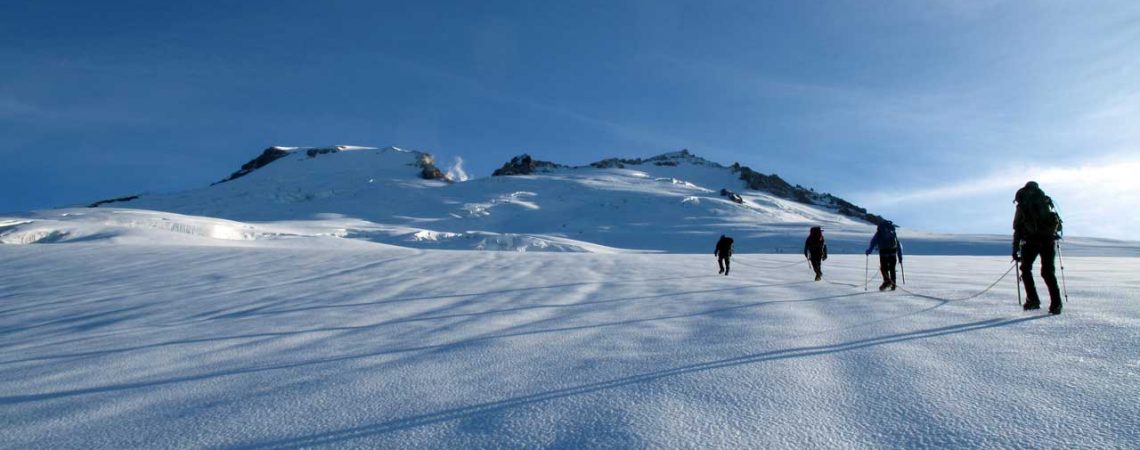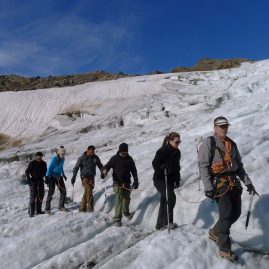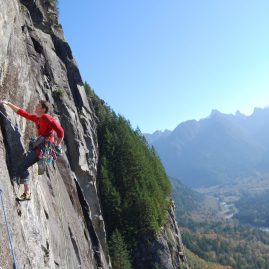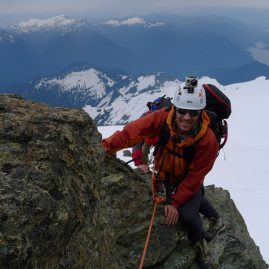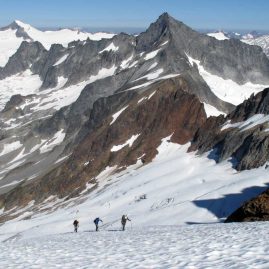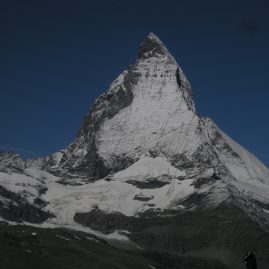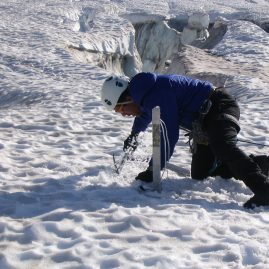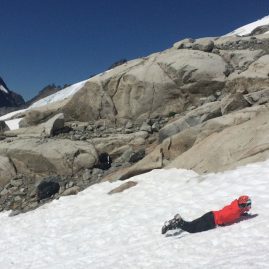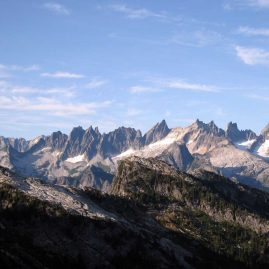Mount Baker-Summit Climb
- 2 Day Dates:
Custom dates available July-September - 3 Day Dates:
Custom dates available July-September - North Ridge Dates:Custom dates available July-September
- Duration: 1-3 days
- Level: Beginner-Intermediate
- Client Ratio: 2:1- 4:1
- Cost:
- 3 Day– $995(based on a min of 2 climbers)
- 2 Day– $765 (based on a min of 2 climbers)
- C2C – $700 (based on a min of 1 climber)
- North Ridge/Coleman Headwall – $1450 (based on 2 climbers)
- Included: Guide, group climbing gear, , tent, breakfast & dinner
- Not Included: Transportation, helmet, harness, carabiners, crampons*, ice axe*, boots*, lunch/trail snacks, gratuities for guides and personal camping equipment.
Book 3 Day Online Now!
Book 2 Day Online Now!
Book C2C Online Now!
Located in the North Cascades, Mount Baker, aka Kulshan-The White Watcher’s fame stems from its accessible, enormous glaciers that climbers gravitate to learn on and challenge themselves whether on the gentle Easton Glacier to the knife edge North ridge. Approaching via the Schrieber’s Meadow, climbers have ample opportunity to practice their glacier mountaineering skills from the comfort of the 6,000′ base camp. From here climbers take in the views of the Twin Sisters Range, Mount Rainier, Mt. Shuksan, and the crest of the North Cascades. The mountain’s abundant alpine terrain make Baker an ideal location to learn snow and glacier travel skills and conditioning in preparation for other Rainier, Denali, Aconcagua, and other high altitude peaks.
On this climb we cover:
- Selection and use of personal equipment, ropes, knots & harnesses
- Crampon use & snow climbing techniques, ice axe positioning, and self arrest techniques
- Roped glacier travel, rope team management, route finding, and crevasse navigation
- Hazard assessment including a discussion of objective vs. subjective hazards
- Camp construction, camp management, and cold weather camping skills.
- Discussions will include proper clothing and climbing gear for survival in the high mountains, mountain weather, alpine ecology, and Leave No Trace ethics.
[/tab]
MULTI-DAY ALPINE CLIMBING EQUIPMENT LIST
Our recommended clothing system has four layers.
- Base layer: manages moisture and wicks perspiration away from your skin. (synthetic or merino wool)
- Softshell: should be a durable, comfortable, insulating and wind/water resistant layer that breathes well.
- Hard shell: windproof, waterproof and breathable. (e.g. Gore-Tex, or similar)
- Insulating layer: should be down-fill or synthetic-fill and fit over all layers. (e.g. down, primaloft or polarguard)
These four layers are usually sufficient for most people, but if you tend to be colder bring one extra medium-layer that would be ideal for extra warmth around camp, such as a vest. When deciding what to pack, remember to bring enough clothes and accessories to ensure your safety and comfort, while not over-burdening yourself with items you probably won’t use.
Climbing Gear
- Adjustable Ski Poles
- Alpine Climbing boots Full shank crampon compatible leather, synthetic, or hybrid boot depending on climb and season.Single-weight synthetic/leather mountaineering boots are adequate for mid and late-summer climbs on Mount Baker and in the North Cascades when conditions are expected to be dry.
- Alpine climbing harness Must have adjustable leg loops and fit over all clothing and can be put on with ski boots
- Ice Axe – Lightweight
- Crampons with anti-ball plate Must be fit to boots prior to trip,
- Climbing/ski helmet Adjustable, should fit with hat on
- 2 locking carabiners – 2 Large, pear-shaped carabiner is best, screw gate type recommended and 2 smaller locking screwgate
- 1 single length sling
- Crevasse Rescue Equipment Kit optional*:
- 4 locking carabiners – 2 Large, pear-shaped carabiner is best, screw gate type recommended and 2 smaller locking screwgate
- 4 regular carabiners (e.g. small wire gate are recommended)
- 1 double length sling
- 1 single length sling
- ! Cordelette 6 mil 18-20’(6-7 meters)
- 1 12” Prussik or Hollow Block*
- 1 Microtraxion & Tibloc*
Upper Body
- 1 synthetic T-shirt
- 1 long sleeve Sun Hoodie or shirt Lightweight, light colored for sunny days
- 2 synthetic sports bras*(WOMEN)
- 1 soft shell jacket
- 1 Down/synthetic jacket with hood
- 1 Hard shell jacket with hood Waterproof and breathable. Gore-Tex or equivalent is best, roomy enough to fit over multiple layers.
- 1 pair lightweight gloves
- 1 pair warm waterproof gloves
- Warm hat Wool or synthetic
- Balaclava/Buff
- Shade hat or Visor
Lower Body
- 2 pair med- heavy wool/synthetic socks Check boot fit with liner and wool socks on
- 1 pair lightweight long underwear
- 1-2 pairs of underwear boxers/briefs
- Softshell pants
- Shell pants Waterproof/breathable with full side zips
Sleeping Gear
- Sleeping bag Rated to at least 20º F. Line the stuff sack w/ plastic bag.
- Sleeping pad 1 closed cell foam and/or Neo-Air for extra warmth and comfort.
Backpack
- Internal frame pack 3500-4500 cubic inch capacity able to carry snowboard/skis
Miscellaneous Equipment
- Goggles and Sunglasses 100% UV protection with side shields or wrap around.
- Personal first aid repair kit Basics: moleskin/blister kit, Band-Aids, first-aid tape, ibuprofen, personal medications, and batteries etc.
- Lip balm At least SPF 20
- Sunscreen At least SPF 40
- Headlamp lightweight LED
- 2 water bottles 1 liter wide-mouth Nalgene and 1 bottle holster, or
- Hydration bladder With drinking tube and 1 Nalgene bottle
- Bowl and spoon Plastic, small Tupperware works well. Lexan spoons are best.
- Toiletry kit Be sure to include WAG Bag or toilet paper stored in a plastic bag.
- Bandana
- Hand wipes
- Favorite snack foods (no more than 2 pounds)
Day 1: Drive from Seattle to the trailhead at Schreiber’s Meadow (3,200 feet) on the south side of Mt. Baker. Approximate driving time is 2.5 hours. The hike to base camp at 6,00 feet takes about 3 to 4 hours. We will travel through lush ancient forests, high alpine meadows, and snow covered areas en route to our high camp. After setting up camp, we will perform an equipment check and skills assessment. We spend the afternoon learning the essentials of glacier travel; ice axe / crampon use, self arrest, rope team travel and basic hazard assessment. The remainder of the evening is spent making final preparations for the next day’s summit attempt.
Day 2: The second day begins early with an alpine start followed by a quick breakfast – Typically between 2 and 3 a.m. is our start time for the climb. Depending on conditions and the pace of your group, it takes from 5 to 7 hours to reach the top. Gorgeous views of the North Cascades reward you as you stand on the summit of the North Cascades’ highest volcano. We return to base camp by early afternoon and you will enjoy an early evening celebratory dinner before getting some well needed rest.
Day 3: After a relaxing breakfast we break down camp, and descend to our vehicle. Plan to be back in Seattle by 4-7 p.m.
NOTE: Depending on weather conditions, your group may summit on the third day of the itinerary. This contingent makes for a long day making your arrival time in Seattle later in the evening, often by 9-10 p.m.
Day 1: Elevation 3,700 feet / 1128 meters
Drive from Seattle to the Heliotrope Ridge trailhead (3,700 feet) on the North side of Mt. Baker. Approximate driving time is 3 hours. The approach to base camp at 6,000 feet takes 3 to 4 hours. We will travel through lush ancient forests, high alpine meadows, and snow covered areas en route to our high camp. After setting up camp, we will perform a skills assessment. We spend the afternoon learning the essentials of of glacier travel; ice axe / crampon technique, self arrest, roped team travel, route finding, and hazard assessment. The remainder of the evening is spent making final preparations for the next day’s summit attempt.
Day 2: The second day begins early with an alpine start followed by a quick breakfast – typically between 2 and 3 a.m is our start time for the climb. Depending on conditions and the pace of the group, it takes from 5 to 7 hours to reach the top. Gorgeous views of the North Cascades reward you as you stand on the summit of the North Cascades’ highest volcano. We return to base camp by early afternoon. After a brief rest, we break down camp, and descend to our vehicle. Plan to be back in Seattle by 6-7 p.m.
Day 1: Drive from Seattle to the Heliotrope Ridge trailhead (3,700 feet) on the North side of Mt. Baker. Approximate driving time is 3 hours. The approach to base camp at 6,000 feet takes 3 to 4 hours. We will travel through lush ancient forests, high alpine meadows, and snow covered areas en route to our high camp. After setting up camp, we eat a big dinner and head to bed early.
Day 2: The day begins with an alpine start – usually between 1 and 2 a.m.
North Ridge: The standard start crosses a double bergshrund and then goes up a broad gulley feature of 40 degree snow. Straightforward glacier travel on the central ridge section steepens into ice slopes that lead up to the base of the prominent ice cliff spanning the bulk of the north face. As the angles steepen we’ll start belaying and then climb, in a classic and exposed position, directly up the ice cliff in a few short pitches (60-80 degrees). Beyond this it’s more glacier travel, some short and steep traverses, and the final summit plateau.
Coleman Headwall: Our route travels up the right-center of the Coleman Glacier, weaving around large crevasses to the base of the Headwall proper. The climbing starts on moderate (40°-50°) snow and ice slopes with the occasional short, steep ice section (~70° to near vertical). Depending on the line taken, the middle of the route consists of a very aesthetic ice arête, or long moderate snow and ice slopes broken by big crevasses. The final ice face is one of Baker’s most beautiful features and is broken by a large bergshrund that can provide steep and exciting climbing.
Depending on conditions and the pace of the group, it takes from 8 to 12 hours to reach the top. Gorgeous views of the Cascades reward you as you stand on the summit of the North Cascade’s highest volcano. We descend via the standard Coleman-Deming route, down the Roman Wall to a saddle between the Black Buttes and Baker’s summit, and onto the lower Coleman and our camp.
Day 3: Break down camp and descend to the trailhead. Alternatively, and for those wanting to sample more of the great alpine ice climbing on the Baker’s north side, we could do a few hours of seracing on the lower Coleman Glacier to round out a full trip.


